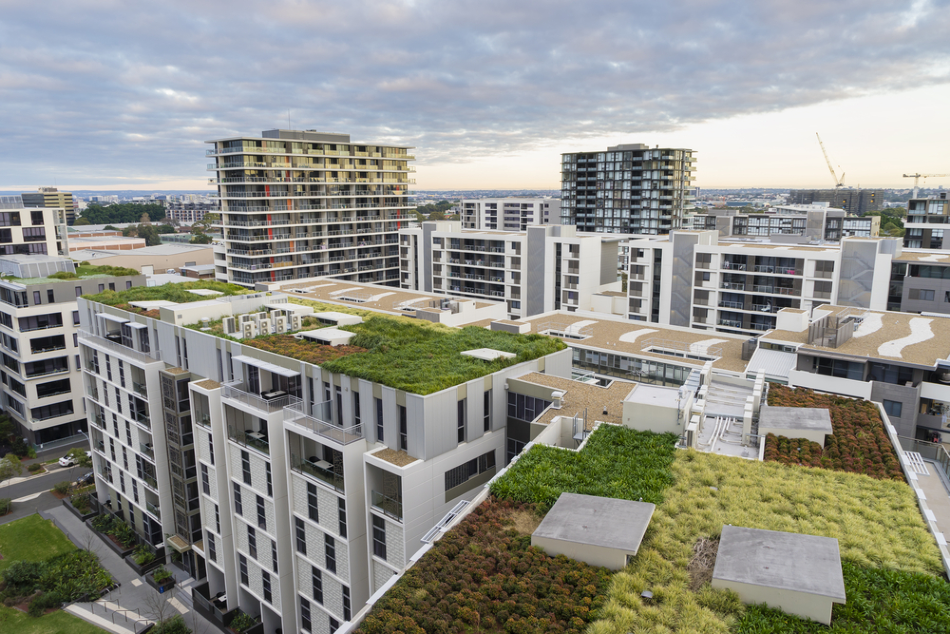
Image Credit: Sunflowerey/Shutterstock.com
More than 20 billion tons of carbon are emitted as a result of the burning of fossil fuels. Half of this is absorbed by the seas and vegetation and the other half remains in the atmosphere. The impact of this on natural ecosystems and on humans is detrimental. Up to 40% of global basic resources are taken up by the construction sector. This statistic emphasizes the need for more environmentally friendly approaches in all areas of our lives.
Background
Green roofs and green roofing systems are rarely the color green but are part of a building that takes the environment into account to save money, resources, or both. Green roofs can be broken down into the categories of:
- Solar roofs
- Cool roofs
- Garden roofs
Solar Roofs
Solar roofs harness the power of the sun to provide heating or electricity. A solar roof can use special collector units to heat water for hot water within the home or to warm swimming pools to extend the annual swimming season. The other form of solar roof uses a roof-mounted array of photovoltaic panels to generate electricity. The electricity produced can be a stand-alone unit that powers just the building it is mounted to or it may be connected to the power grid where it will feed back excess electricity.
Benefits of Solar Roofs
Solar or photovoltaic energy offers the following benefits:
- Fixed cost once the system is installed
- In most areas, excess power can be sold back to the grid for a good return on investment
- Highly reliable with low maintenance
- Silent and emission-free electricity generation
Cool Roofs
Cool roofs are the simplest form of green roof. Although all roofing materials reflect a certain amount of heat, a cool roof is one that will both reflect the light and UV rays from the sun while retaining very little heat. Cool roofs are made from materials that are highly reflective and highly emissive. These properties are retained with little maintenance for the life of the roof.
Benefits of Cool Roofs
The benefits of cool roofs include:
- Long life cycle
- Long warranties and low maintenance
- Reduction in heat absorption from urban areas
- Lower requirement for heating and air conditioning
- Recyclable and can be made from renewable resources
Garden Roofs
Garden roofs have various plants and vegetation growing on the roof of a building. Urban agriculture is a continuously growing field that offers alternative spaces for vegetable production in big cities. Urban communities in bigger cities all around the world benefit from creating green roof spaces to grow vegetables which facilitates the integration of agriculture. A garden roof will insulate the building below it while blending into the surrounding environment, and depending on the plants used, it may provide food for the building occupants.
Southern Illinois University Carbondale (SIUC) Green Roof
The suitability of rooftops for the production of vegetable crops has been tested via studies conducted on the SIUC green roof. This research emphasizes the importance of a good fertility management systems that provide essential amounts of mineral nutrients and maintaining moisture levels to aid optimal growing conditions.
The purpose of the study was to determine the effectiveness of various fertility systems for growing shallow-rooted vegetables such as kale, lettuce, and radish. The study was conducted during the autumn growing season and results show that all crops could be produced in an extensive roof system as long as an appropriate nutrition system is in place.
The increasing demand for locally produced foods and the available opportunities and space in urban areas food production programs for green roofs are becoming more and more popular.
Types of Garden Roofs
There are four types of roofs that incorporate vegetation as its foundation.
- Intensive roofs: In simple terms, intensive green roofs are parks and gardens on the rooftops of buildings. Intensive green roofs need deeper soil and require higher maintenance. They are a good stormwater management solution as they store a great deal of water. Intensive roofs provide good a thermal barrier and are good for biodiversity.
- Extensive roofs: They have a thinner growing medium and require less maintenance than intensive roofs.
- Blue-green roofs: These types of roofs aim to increase the amount of water stored and released. It is a smart way to combine the benefits of a green roof with the water storage system provided by blue roofs.
- Biosolar green roofs: Solar energy and green roof technology is combined to deliver renewable energy and promote biodiversity.
Benefits of Garden Roofs
Garden roof systems have the following benefits:
- Heat and sound insulation
- Energy conservation
- Reduction in heat absorption from urban areas
- Lower requirement for heating and air conditioning
- Control of stormwater runoff and erosion
- Improvement of water and air quality
- Increased service life of the roof
- Increased urban wildlife habitat
- Improved urban aesthetics
Sources and Further Reading
This article was updated on 21st February, 2020.
Disclaimer: The views expressed here are those of the author expressed in their private capacity and do not necessarily represent the views of AZoM.com Limited T/A AZoNetwork the owner and operator of this website. This disclaimer forms part of the Terms and conditions of use of this website.